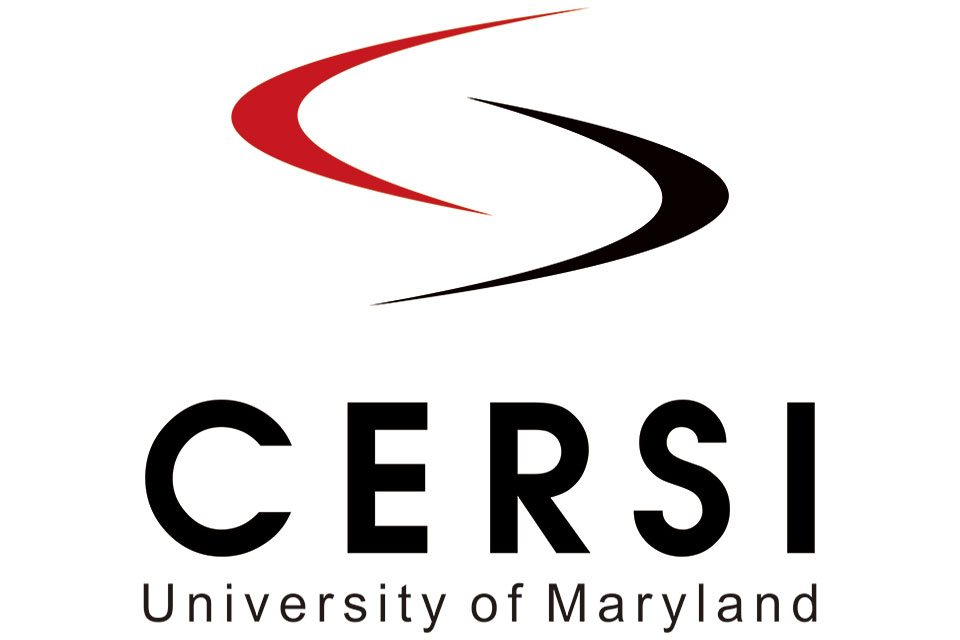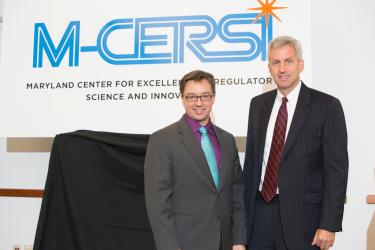CERSI Symposium Highlights Use of Biomarkers in Drug Development
More than 500 researchers from academia, government, and industry gather to gain perspective on biomarker development and the application of biomarkers in preclinical and clinical research.

By Malissa Carroll
August 28, 2015
On August 21, the University of Maryland School of Pharmacy welcomed researchers from academia, government, and industry to “Evidentiary Considerations for Integration of Biomarkers in Drug Development,” a symposium jointly sponsored by the University of Maryland Center of Excellence in Regulatory Science and Innovation (CERSI), the Critical Path Institute (C-Path), and the Food and Drug Administration (FDA).
“Our work through the CERSI initiative uniquely positions the School of Pharmacy to host this symposium,” said Natalie D. Eddington, PhD, FCP, FAAPS, dean and professor of the School of Pharmacy, who welcomed symposium attendees to the School. “Working within our silos of academia, government, and industry, it can be challenging to move scientific concepts for new drugs and improved drug delivery techniques into the hands of the individuals who need them most – the patients. However, by working together and harnessing our collective ingenuity through conferences like today’s, we are more likely to make a significant and real impact on the treatment of acute and chronic diseases.”
With more than 500 individuals attending either in-person or via live webinar, the symposium organized by Jia Bei Wang, PhD, professor in the Department of Pharmaceutical Sciences (PSC) at the School, and James Polli, PhD, the Shangraw/Noxell Endowed Chair in Industrial Pharmacy and Pharmaceutics in PSC, in collaboration with the FDA and C-Path, was the most well-attended of all CERSI-sponsored conferences held in recent years, providing participants with an opportunity to gain perspective on biomarker development and the application of biomarkers in preclinical and clinical research.
Biomarkers refer to any biological molecule found in an individual’s blood, bodily fluids, or tissues that indicates the presence of disease, infection, or environmental exposure.
“Biomarkers are critical to helping facilitate disease detection, stratify patients into subpopulations, predict patients’ prognosis, evaluate patients’ responses to treatment, and help researchers better understand a disease’s underlying cause,” says Wang. “The goal of this symposium was to identify ways that researchers can use biomarkers to better evaluate drug safety and efficacy in both preclinical and clinical studies. This is a topic that truly needs a lot of attention, and we appreciated the opportunity to partner with the FDA and C-Path — recognized leaders in the field of biomarker development — to host this event.”
The symposium was divided into four sessions. Janet Woodcock, MD, director of the Center for Drug Evaluation and Research at the FDA, delivered the keynote address, which set the framework for the symposium and outlined the goals that participants should aim to achieve to continue moving the field forward.
“Biomarkers have long been used in clinical medicine, but the FDA only recently became involved with qualifying them for drug development,” said Woodcock, who received an honorary doctor of science degree from the University of Maryland, Baltimore in 2013 – an honor for which she was nominated by the School of Pharmacy. “With our organization now involved in biomarker qualification, we – academia, government, and industry – are all learning together. We have accomplished a lot in recent years, but we must continue working together to shape evidentiary standards and develop a universal classification system that will allow us to talk to each other about this important field of research and better understand the goals that our respective sectors are trying to accomplish.”
Following Woodcock, Shashi Amur, PhD, biomarker qualification scientific coordinator in the Center for Drug Evaluation and Research at the FDA, delivered the symposium’s first research presentation, introducing the concept of biomarker “context of use.”
“Context of use is divided into two parts, and is very important in biomarker qualification,” explained Amur. “The first part is the use statement, which includes the biomarker’s name, identity, and explanation of its use in drug development. The second part outlines its conditions for qualified use. There are many types of biomarkers, and one biomarker can have multiple contexts of use.”
The concept of “context of use” was expanded upon in many other presentations delivered during the symposium, though it resonated most with those researchers addressing statistical considerations for clinical biomarkers – a topic that garnered a lot of attention throughout the symposium.
“Biomarker qualification uses robust statistical methods to confirm whether a biomarker fulfills a set of conditions for its intended use in the clinic,” explained Robin Mogg, PhD, scientific director for statistical modeling at the Janssen Pharmaceutical Companies of Johnson & Johnson. “While interest surrounding the statistical perspective of biomarker qualification has increased in recent years, there still exist no universal evidentiary standards that clearly define qualification – a problem likely fueled by the knowledge that these standards rely heavily upon the biomarker’s intended context of use, which could include a variety of different applications.”
Echoing Mogg’s presentation, Suzanne Hendrix, PhD, president of Pentara Corporation, addressed the issue of “context of use” specifically as it affects enrichment biomarkers – those biomarkers used to improve diagnostic, prognostic, and predictive accuracy for a range of diseases. She added, “Understanding the sources of variability in biomarker outcomes, as well as the goal of the enrichment, will help researchers develop an improved statistical approach to validate the biomarker for its intended context of use.”
Although not all of the symposium’s participants agreed on the importance placed on this concept, with some researchers advocating for other measures against which biomarkers should be qualified, all attendees agreed that the event provided valuable insights into this often challenging area of research.
“Biomarkers are already having a tremendous impact in clinical medicine, and once we are able to qualify them, that impact is only going to evolve,” noted one audience member during the symposium’s concluding panel discussion. “This is truly an exciting area of research, and I look forward to witnessing the developments that are sure to come in this field.”



